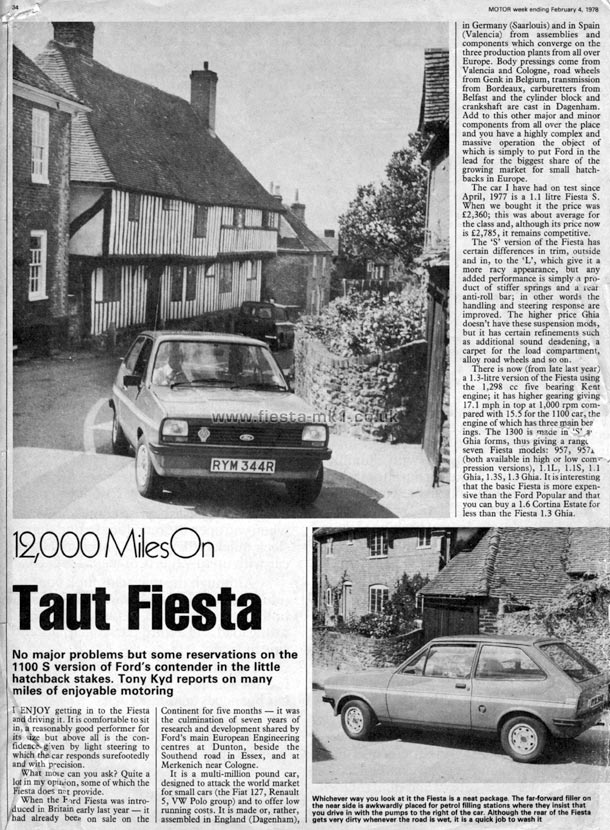Copy of Article Text Below
12,000 Miles On - Taut Fiesta
No major problems but some reservations on the 1100S version of Ford's contender in the little hatchback stakes. Tony Kyd reports on many miles of enjoyable motoring
I ENJOY getting in to the Fiesta and driving it. It is comfortable to sit in, a reasonably good performer for its size but above all is the confidence given by light steering to which the car responds surefootedly and with precision.
What more can you ask? Quite a lot in my opinion, some of which the Fiesta does not provide.
When the Ford Fiesta was introduced in Britain early last year - it had already been on sale on the Continent for five months - it was the culmination of seven years of research and development shared by Ford's main European Engineering centres at Dunton, beside the Southend road in Essex, and at Merkenich near Cologne.
It is a multi-million pound car, designed to attack the world market for small cars (the Fiat 127, Renault 5, VW Polo group) and to offer low running costs. It is made or, rather, assembled in England (Dagenham), in Germany (Saarlouis) and in Spain (Valencia) from assemblies and components which converge on the three production plants from all over Europe. Body pressings come from Valencia and Cologne, road wheels from Genk in Belgium, transmission from Bordeaux, carburetters from Belfast and the cylinder block and crankshaft are cast in Dagenham. Add to this other major and minor components from all over the place and you have a highly complex and massive operation the object of which is simply to put Ford in the lead for the biggest share of the growing market for small hatchbacks in Europe.
The car I have had on test since April, 1977 is a 1.1 litre Fiesta S. When we bought it the price was £2,360; this was about average for the class and, although its price now is £2,785, it remains competitive.
The 'S' version of the Fiesta has certain differences in trim, outside and in, to the 'L', which give it a more racy appearance, but any added performance is simply a product of stiffer springs and a rear anti-roll bar; in other words the handling and steering response are improved. The higher price Ghia doesn't have these suspension mods, but it has certain refinements such as additional sound deadening, a carpet for the load compartment, alloy road wheels and so on.
There is now (from late last year) a 1.3-litre version of the Fiesta using the 1,298 cc five bearing Kent engine; it has higher gearing giving 17.1 mph in top at 1,000 rpm compared with 15.5 for the 1100 car, the engine of which has three main bearings. The 1300 is made in 'S' and Ghia forms, thus giving a range of seven Fiesta models: 957, 957L (both available in high or low compression versions), 1.1L, 1.1S, 1.1 Ghia, 1.3S, 1.3Ghia. It is interesting that the basic Fiesta is more expensive than the Ford Popular and that you can buy a 1.6 Cortina Estate for less than the Fiesta 1.3 Ghia......
Captions -
Bottom-Right - Whichever way you look at it the Fiesta is a neat package. The far-forward filler on the near side is awkwardly placed for petrol filling stations where they insist that you drive in with the pumps to the right of the car. Although the rear of the Fiesta gets very dirty whenever the road is wet, it is a quick job to wash it
|



